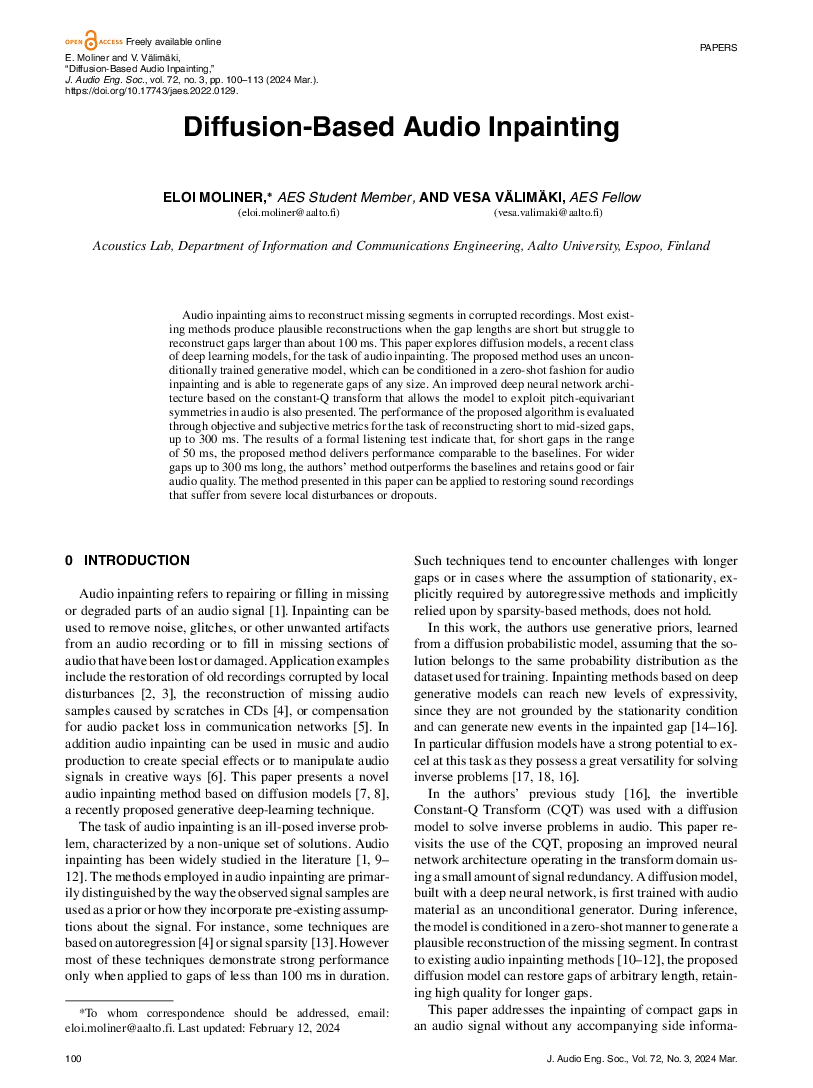Home / Publications / E-library page
You are currently logged in as an
Institutional Subscriber.
If you would like to logout,
please click on the button below.
Home / Publications / E-library page
Only AES members and Institutional Journal Subscribers can download
Audio inpainting aims to reconstruct missing segments in corrupted recordings. Most existing methods produce plausible reconstructions when the gap lengths are short, but struggle to reconstruct gaps larger than about 100 ms. This paper explores diffusion models, a recent class of deep learning models, for the task of audio inpainting. The proposed method uses an unconditionally trained generative model, which can be conditioned in a zero-shot fashion for audio inpainting, and is able to regenerate gaps of any size. An improved deep neural network architecture based on the constant-Q transform that allows the model to exploit pitchequivariant symmetries in audio is also presented. The performance of the proposed algorithm is evaluated through objective and subjective metrics for the task of reconstructing short to mid-sized gaps, up to 300 ms. The results of a formal listening test indicate that, for short gaps in the range of 50 ms, the proposed method delivers performance comparable to the baselines. For wider gaps up to 300 ms long, our method outperforms the baselines and retains good or fair audio quality. The method presented in this paper can be applied to restoring sound recordings that suffer from severe local disturbances or dropouts.
Author (s): Moliner, Eloi; Välimäki, Vesa
Affiliation:
Acoustics Lab, Department of Information and Communications Engineering, Aalto University, Espoo, Finland; Acoustics Lab, Department of Information and Communications Engineering, Aalto University, Espoo, Finland
(See document for exact affiliation information.)
Publication Date:
2024-03-06
Import into BibTeX
Permalink: https://aes2.org/publications/elibrary-page/?id=22383
(985KB)
Click to purchase paper as a non-member or login as an AES member. If your company or school subscribes to the E-Library then switch to the institutional version. If you are not an AES member Join the AES. If you need to check your member status, login to the Member Portal.

Moliner, Eloi; Välimäki, Vesa; 2024; Diffusion-Based Audio Inpainting [PDF]; Acoustics Lab, Department of Information and Communications Engineering, Aalto University, Espoo, Finland; Acoustics Lab, Department of Information and Communications Engineering, Aalto University, Espoo, Finland; Paper ; Available from: https://aes2.org/publications/elibrary-page/?id=22383
Moliner, Eloi; Välimäki, Vesa; Diffusion-Based Audio Inpainting [PDF]; Acoustics Lab, Department of Information and Communications Engineering, Aalto University, Espoo, Finland; Acoustics Lab, Department of Information and Communications Engineering, Aalto University, Espoo, Finland; Paper ; 2024 Available: https://aes2.org/publications/elibrary-page/?id=22383